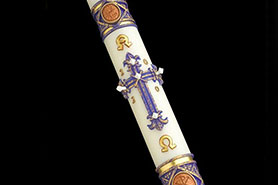The Origin of the Paschal Candle
04-09-2019
We’ve already covered what a Paschal candle is in an earlier post, but to recap: it is a pure, white candle made of beeswax. It represents both Jesus’ humanity and his divine nature. Each Paschal candle has five grains of incense to represent the five wounds of crucifixion. During the Easter Vigil, the priest carries the candle into a dark church - the new light representing eternal life in Christ. The candle remains near the altar for the next year and is used only during special occasions (such as baptisms).
The origins of the Paschal candle are a bit unclear, but most theologians tie it (at least in part) to the Jewish tradition of lighting a candle at the end of Sabbath, so the foundation of the practice was in place during the birth of Christianity. There is record that the solemn tradition of the Paschal candle as a uniquely Christian practice was established no later than the 4th century (and likely earlier).
The Paschal candle uses and procedures have definitely changed over time. At one point in time, it was broken after the Easter Vigil and pieces were given to Christians. This transitioned by the 10th century and the practice of keeping it in an honored place near the Gospel began. It was a few hundred years later that Paschal candles were inscribed with the year (a practice that continues today). Around that time, Paschal candles were growing in size; today, they continue to be the largest candle in a church. So, since around the 12th century, the Paschal candle traditions mirror closely what Catholics do today. What a rich and important history.

